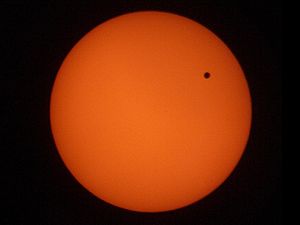
Transit of Venus, 2004
Encyclopedia

Transit of Venus
A transit of Venus across the Sun takes place when the planet Venus passes directly between the Sun and Earth, becoming visible against the solar disk. During a transit, Venus can be seen from Earth as a small black disk moving across the face of the Sun...
when observed from Earth
Earth
Earth is the third planet from the Sun, and the densest and fifth-largest of the eight planets in the Solar System. It is also the largest of the Solar System's four terrestrial planets...
took place on June 8, 2004. The event received significant attention, since it was the first Venus transit to take place after the invention of broadcast media. No human alive at the time had witnessed a previous Venus transit, since the previous Venus transit took place on December 6, 1882.
European Southern Observatory (ESO)
ESO
ESO, as a three-letter abbreviation, may stand for:* European Southern Observatory* Ensemble Studios Online* English Symphony Orchestra* Edmonton Symphony Orchestra* Executive Stock Options...
and the European Association for Astronomy Education (EAAE) launched the VT-2004 project, together with the Institut de Mécanique Céleste et de Calcul des Éphémérides (IMCCE) and the Observatoire de Paris in France, as well as the Astronomical Institute of the Academy of Sciences of the Czech Republic. This project had the intention of using this celestial event to try to transform people's curiosity into knowledge and interest in science through a broad set of actions.
This project had 2763 participants all over the world, including nearly 1000 school classes. The participants made a measurement of the astronomic unit (AU) of 149 608 708 km ± 11 835 km which had only a 0.007% difference to the accepted value.
Visibility

Europe
Europe is, by convention, one of the world's seven continents. Comprising the westernmost peninsula of Eurasia, Europe is generally 'divided' from Asia to its east by the watershed divides of the Ural and Caucasus Mountains, the Ural River, the Caspian and Black Seas, and the waterways connecting...
, Asia
Asia
Asia is the world's largest and most populous continent, located primarily in the eastern and northern hemispheres. It covers 8.7% of the Earth's total surface area and with approximately 3.879 billion people, it hosts 60% of the world's current human population...
and Africa
Africa
Africa is the world's second largest and second most populous continent, after Asia. At about 30.2 million km² including adjacent islands, it covers 6% of the Earth's total surface area and 20.4% of the total land area...
, although eastern North America
North America
North America is a continent wholly within the Northern Hemisphere and almost wholly within the Western Hemisphere. It is also considered a northern subcontinent of the Americas...
caught the end of it. Western North America
North America
North America is a continent wholly within the Northern Hemisphere and almost wholly within the Western Hemisphere. It is also considered a northern subcontinent of the Americas...
did not see it at all, nor did Hawaii
Hawaii
Hawaii is the newest of the 50 U.S. states , and is the only U.S. state made up entirely of islands. It is the northernmost island group in Polynesia, occupying most of an archipelago in the central Pacific Ocean, southwest of the continental United States, southeast of Japan, and northeast of...
or New Zealand
New Zealand
New Zealand is an island country in the south-western Pacific Ocean comprising two main landmasses and numerous smaller islands. The country is situated some east of Australia across the Tasman Sea, and roughly south of the Pacific island nations of New Caledonia, Fiji, and Tonga...
.
The regions from which the transit were visible are shown on the map to the right.
Timing
The following table and image give times for various events (respectively, first contact, second contact, the mid-point, third contact and fourth contact) during of the transit on June 8, 2004 for a hypothetical observer at the center of the Earth. Due to parallaxParallax
Parallax is a displacement or difference in the apparent position of an object viewed along two different lines of sight, and is measured by the angle or semi-angle of inclination between those two lines. The term is derived from the Greek παράλλαξις , meaning "alteration"...
, actual observed times may differ by as much as ±7 minutes at different observation points on Earth.
| Times (UTC) for observations of the transit on June 8, 2004 |
||||
|---|---|---|---|---|
| I | II | Mid | III | IV |
| 05:13:29 | 05:32:55 | 08:19:44 | 11:06:33 | 11:25:59 |
External links
- June 8, 2004: The Transit of Venus by John E. Westfall, ALPOAssociation of Lunar and Planetary ObserversThe Association of Lunar and Planetary Observers is an international scientific and educational organization established in March, 1947 in the United States by Walter H. Haas, and later incorporated in 1990...
- The Venus Transit Across the Sun; observations from Hartwick College in Oneonta, NY, USA
- Several videos of the transit as seen by the TRACE satellite
- Archive of observations in Bangalore
- Predictions for the 2004 Transit of Venus
- The Transit of Venus: Where to See It
- Photos taken by BBC News readers
- Venus Transit 2004 Homepage at European Southern Observatory
- Venus Transit 2004 - Miami, FL, USA
- HM Nautical Almanac Office: 2004 Transit of Venus
- Astronomy Picture of the Day 2004 June 10 -- Transit closeup photo
- Images of the 2004 Transit of Venus by Crayford Manor House Astronomical Society

